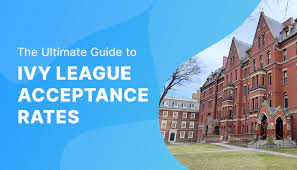Ivy League Acceptance Rate, The Ivy League is synonymous with academic excellence, prestigious institutions, and rigorous admissions processes. Comprised of eight elite universities—Harvard, Yale, Princeton, Columbia, University of Pennsylvania, Dartmouth, Brown, and Cornell—these schools represent the pinnacle of higher education in the United States. With their prestigious reputations and highly competitive acceptance rates, gaining admission to an Ivy League institution is a coveted achievement for students worldwide. In this article, we will explore the acceptance rates of the Ivy League schools, the factors influencing these rates, and what prospective students need to know to navigate the admissions process effectively.
Historical Overview of Ivy League Acceptance Rates
To understand the current state of Ivy League acceptance rates, it’s essential to consider their historical context.
Early Trends
In the early 20th century, Ivy League schools had relatively higher acceptance rates compared to today. During this period, the applicant pool was smaller, and the concept of college admissions was less competitive. As these institutions grew in stature and influence, the number of applicants began to rise, leading to more selective admissions processes.
Recent Trends
Over the past few decades, Ivy League acceptance rates have declined significantly. For example, in the 1990s, acceptance rates at many Ivy League schools were around 10-15%. By the 2010s, this rate had dropped to below 10%, and in recent years, some schools have seen acceptance rates fall below 5%.
This decline reflects the increasing number of applications and the growing desire for an Ivy League education. For instance, in the 2022-2023 admissions cycle, Harvard had an acceptance rate of just 3.4%, while Yale’s rate was 4.5%. This intense competition highlights the prestige of Ivy League schools and the high demand for their programs.
Factors Influencing Ivy League Acceptance Rates
Several key factors contribute to the low acceptance rates at Ivy League schools. Understanding these factors can help prospective students better prepare for the admissions process.
Surge in Applications
One of the primary reasons for the low acceptance rates is the significant increase in applications. Ivy League schools have seen a dramatic rise in the number of applications over the years. For example, in the 2021-2022 admissions cycle, the number of applications to Ivy League schools collectively exceeded 200,000.
This surge can be attributed to several factors, including the widespread availability of application platforms like the Common Application, increased global awareness of Ivy League institutions, and the desire for a degree from a prestigious university. As more students apply, the competition becomes fiercer, driving down the acceptance rate.
Holistic Admissions Process
Ivy League schools employ a holistic admissions process, which means they evaluate applicants based on a range of criteria beyond just academic performance. This process includes:
- Academic Excellence: While high grades and test scores are crucial, Ivy League schools also consider the rigor of coursework and academic achievements.
- Extracurricular Involvement: Applicants are assessed on their involvement in extracurricular activities, leadership roles, and contributions to their communities.
- Personal Essays: Essays play a significant role in showcasing an applicant’s personality, interests, and fit for the institution.
- Letters of Recommendation**: Strong recommendations from teachers or mentors provide insight into an applicant’s character and potential.
The holistic approach means that admissions decisions are based on a comprehensive evaluation, making the process highly competitive and contributing to the low acceptance rates.
Focus on Diversity and Inclusion
Ivy League schools are committed to creating diverse and inclusive campuses. This commitment includes seeking students from various backgrounds, cultures, and experiences. While diversity enhances the educational environment, it also impacts acceptance rates, as the schools aim to balance their student bodies in terms of academic achievements, geographic representation, and personal experiences.
Admissions committees prioritize diversity in their decision-making processes, looking for candidates who bring unique perspectives and experiences to their campuses. This focus on diversity can further reduce the number of students admitted, as the pool of applicants becomes increasingly competitive.
Global Reputation and Prestige
The Ivy League’s global reputation for academic excellence and prestige contributes to its low acceptance rates. These institutions are renowned for their rigorous programs, distinguished faculty, and influential alumni. As a result, students from around the world aspire to attend Ivy League schools, leading to a higher volume of applications.
The reputation of Ivy League institutions also attracts highly qualified candidates who excel in various fields. This competitive applicant pool makes it challenging for any single applicant to stand out, further lowering the acceptance rate.
Implications for Prospective Students
Understanding the factors behind Ivy League acceptance rates can help prospective students navigate the admissions process more effectively. Here are some key considerations:
Challenges for Applicants
The primary challenge for applicants is the intense competition. With a low acceptance rate and a high volume of highly qualified candidates, standing out in the admissions process can be daunting. Many applicants have outstanding academic records, exceptional extracurricular achievements, and compelling personal stories.
Another challenge is the holistic nature of the admissions process. Applicants must excel in multiple areas, including academics, leadership, and personal qualities. This multifaceted evaluation requires students to present a well-rounded and impressive application.
Application Strategy
To enhance their chances of admission, prospective students should consider the following strategies:
1. **Demonstrate Unique Strengths**: Highlight achievements, projects, or experiences that set you apart from other applicants. Showcasing unique talents or contributions can make a significant impact.
2. **Excel Academically**: Maintain high academic standards and excel in challenging coursework. Ivy League schools look for students who demonstrate academic rigor and excellence.
3. **Craft Compelling Essays**: Use personal essays to provide insight into your character, interests, and goals. Be authentic and reflective, and ensure your essays align with the values and mission of the Ivy League institutions.
4. **Secure Strong Recommendations**: Obtain letters of recommendation from individuals who can provide detailed and personalized insights into your strengths and potential. Choose recommenders who know you well and can speak to your achievements and character.
5. **Engage in Meaningful Extracurriculars**: Involve yourself in extracurricular activities that reflect your passions and leadership abilities. Ivy League schools value students who are actively engaged and make significant contributions to their communities.
6. **Apply Strategically**: Consider applying to a mix of Ivy League and other selective institutions. This balanced approach ensures that you have a range of options and reduces the stress associated with the admissions process.
Realistic Expectations
Given the low acceptance rates, it’s important for applicants to maintain realistic expectations. While aiming for Ivy League schools is admirable, it’s crucial to build a diverse college list that includes a mix of reach, match, and safety schools. This approach will help you find the best fit for your academic and personal goals, regardless of the admissions outcome.
The Future of Ivy League Acceptance Rates
Several trends may influence Ivy League acceptance rates in the coming years. While predicting exact changes is challenging, understanding these potential trends can provide valuable insights for prospective students.
Potential Trends
1. **Continued Increase in Applications**: The trend of rising applications is likely to continue, driven by the global recognition of Ivy League institutions and the ease of applying through common platforms. This may further decrease acceptance rates as the applicant pool grows.
2. **Evolving Admissions Policies**: Ivy League schools may continue to adapt their admissions policies in response to changing educational trends. This includes exploring new evaluation methods or adjusting criteria to align with their institutional goals.
3. **Focus on Holistic Review**: The emphasis on holistic admissions is expected to remain strong. Ivy League schools will likely continue to prioritize a comprehensive evaluation of applicants, balancing academic achievements with personal qualities and extracurricular involvement.
4. **Increased Emphasis on Diversity**: The commitment to diversity and inclusion will likely remain a priority. Ivy League schools will continue to seek students from diverse backgrounds, which may impact acceptance rates as they strive to build a well-rounded and representative student body.
ALSO READ: Stanford University Acceptance Rate 2024
Conclusion
In conclusion, Ivy League acceptance rates reflect the highly competitive nature of these prestigious institutions. The low acceptance rates are driven by factors such as a surge in applications, a holistic admissions process, a focus on diversity, and the global reputation of the Ivy League schools. While the competition is fierce, understanding these factors and adopting effective application strategies can improve your chances of success.
As you prepare for the admissions process, remember to present your unique strengths, excel academically, and explore a range of college options. By keeping an open mind and focusing on finding the right fit for your academic and personal goals, you’ll be well-prepared to navigate the college admissions landscape and achieve your aspirations.
Additional Resources
For more information on Ivy League admissions, visit the [Ivy League’s official website]. For guidance on crafting a standout college application, check out this [college application guide]). If you have specific questions about Ivy League admissions and acceptance rates, consider exploring forums or reaching out to current students or alumni for insights.
Discover more from
Subscribe to get the latest posts sent to your email.



